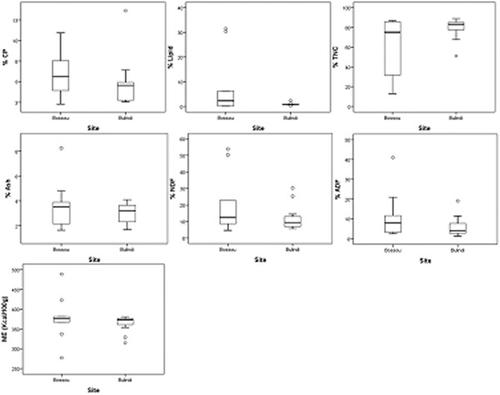当前位置:
X-MOL 学术
›
Am. J. Primatol.
›
论文详情
Our official English website, www.x-mol.net, welcomes your
feedback! (Note: you will need to create a separate account there.)
The macronutrient composition of wild and cultivated plant foods of West African chimpanzees (Pan troglodytes verus) inhabiting an anthropogenic landscape.
American Journal of Primatology ( IF 2.0 ) Pub Date : 2020-01-30 , DOI: 10.1002/ajp.23102 Nicola Bryson-Morrison 1 , Andy Beer 2, 3 , Aly Gaspard Soumah 4 , Tetsuro Matsuzawa 5 , Tatyana Humle 6
American Journal of Primatology ( IF 2.0 ) Pub Date : 2020-01-30 , DOI: 10.1002/ajp.23102 Nicola Bryson-Morrison 1 , Andy Beer 2, 3 , Aly Gaspard Soumah 4 , Tetsuro Matsuzawa 5 , Tatyana Humle 6
Affiliation

|
Agricultural expansion encroaches on tropical forests and primates in such landscapes frequently incorporate crops into their diet. Understanding the nutritional drivers behind crop-foraging can help inform conservation efforts to improve human-primate coexistence. This study builds on existing knowledge of primate diets in anthropogenic landscapes by estimating the macronutrient content of 24 wild and 11 cultivated foods (90.5% of food intake) consumed by chimpanzees (Pan troglodytes verus) at Bossou, Guinea, West Africa. We also compared the macronutrient composition of Bossou crops to published macronutrient measures of crops from Bulindi, Uganda, East Africa. The composition of wild fruits, leaves, and pith were consistent with previous reports for primate diets. Cultivated fruits were higher in carbohydrates and lower in insoluble fiber than wild fruits, while wild fruits were higher in protein. Macronutrient content of cultivated pith fell within the ranges of consumed wild pith. Oil palm food parts were relatively rich in carbohydrates, protein, lipids, and/or fermentable fiber, adding support for the nutritional importance of the oil palm for West African chimpanzees. We found no differences in the composition of cultivated fruits between Bossou and Bulindi, suggesting that macronutrient content alone does not explain differences in crop selection. Our results build on the current understanding of chimpanzee feeding ecology within forest-agricultural mosaics and provide additional support for the assumption that crops offer primates energetic benefits over wild foods.
中文翻译:

居住在人为景观中的西非黑猩猩(Pan troglodytes verus)的野生和栽培植物食品中的大量营养成分。
农业扩张侵占热带森林,在这种景观中的灵长类动物经常将农作物纳入其饮食。了解农作物觅食背后的营养驱动因素,可以有助于保护工作改善人类灵长类动物的共存。这项研究通过估算西非几内亚博索的黑猩猩(Pan troglodytes verus)食用的24种野生和11种耕作食物(占食物摄入量的90.5%)的大量营养素含量,从而基于人为景观中的灵长类动物饮食的现有知识。我们还比较了Bossou作物的常量营养素组成与已发表的东非乌干达Bulindi作物的常量营养素含量指标。野生水果,叶子和髓的组成与灵长类动物饮食的先前报道一致。与野生水果相比,栽培水果的碳水化合物含量更高,不溶性纤维含量更低,而野生水果的蛋白质含量更高。栽培髓的常量营养素含量在食用野生髓的范围内。油棕食品中的碳水化合物,蛋白质,脂质和/或可发酵纤维相对丰富,这为油棕对西非黑猩猩的营养重要性提供了支持。我们发现Bossou和Bulindi之间的栽培水果组成没有差异,这表明仅大量营养素并不能解释作物选择的差异。我们的研究结果基于对森林-农业马赛克中黑猩猩觅食生态学的当前理解,并为农作物比野生食品提供灵长类动物有益的假设提供了额外的支持。而野果的蛋白质含量更高。栽培髓的常量营养素含量在食用野生髓的范围内。油棕食品中的碳水化合物,蛋白质,脂质和/或可发酵纤维相对丰富,这为油棕对西非黑猩猩的营养重要性提供了支持。我们发现Bossou和Bulindi之间的栽培水果组成没有差异,这表明仅大量营养素并不能解释作物选择的差异。我们的研究结果基于对森林-农业马赛克中黑猩猩觅食生态学的当前理解,并为农作物比野生食品提供灵长类动物有益的假设提供了额外的支持。而野果的蛋白质含量更高。栽培髓的常量营养素含量在食用野生髓的范围内。油棕食品中的碳水化合物,蛋白质,脂质和/或可发酵纤维相对丰富,这为油棕对西非黑猩猩的营养重要性提供了支持。我们发现Bossou和Bulindi之间的栽培水果组成没有差异,这表明仅大量营养素并不能解释作物选择的差异。我们的研究结果基于对森林-农业马赛克中黑猩猩觅食生态学的当前理解,并为农作物比野生食品提供灵长类动物有益的假设提供了额外的支持。油棕食品中的碳水化合物,蛋白质,脂质和/或可发酵纤维相对丰富,这为油棕对西非黑猩猩的营养重要性提供了支持。我们发现Bossou和Bulindi之间的栽培水果组成没有差异,这表明仅大量营养素并不能解释作物选择的差异。我们的研究结果基于对森林-农业马赛克中黑猩猩觅食生态学的当前理解,并为农作物比野生食品提供灵长类动物有益的假设提供了额外的支持。油棕食品中的碳水化合物,蛋白质,脂质和/或可发酵纤维相对丰富,这为油棕对西非黑猩猩的营养重要性提供了支持。我们发现Bossou和Bulindi之间的栽培水果组成没有差异,这表明仅大量营养素并不能解释作物选择的差异。我们的研究结果基于对森林-农业马赛克中黑猩猩觅食生态学的当前理解,并为农作物比野生食品提供灵长类动物能量优势的假设提供了额外的支持。我们发现Bossou和Bulindi之间的栽培水果组成没有差异,这表明单独的大量营养素不能解释作物选择的差异。我们的研究结果基于对森林-农业马赛克中黑猩猩觅食生态学的当前理解,并为农作物比野生食品提供灵长类动物有益的假设提供了额外的支持。我们发现Bossou和Bulindi之间的栽培水果组成没有差异,这表明单独的大量营养素不能解释作物选择的差异。我们的研究结果基于对森林-农业马赛克中黑猩猩觅食生态学的当前理解,并为农作物比野生食品提供灵长类动物有益的假设提供了额外的支持。
更新日期:2020-04-13
中文翻译:

居住在人为景观中的西非黑猩猩(Pan troglodytes verus)的野生和栽培植物食品中的大量营养成分。
农业扩张侵占热带森林,在这种景观中的灵长类动物经常将农作物纳入其饮食。了解农作物觅食背后的营养驱动因素,可以有助于保护工作改善人类灵长类动物的共存。这项研究通过估算西非几内亚博索的黑猩猩(Pan troglodytes verus)食用的24种野生和11种耕作食物(占食物摄入量的90.5%)的大量营养素含量,从而基于人为景观中的灵长类动物饮食的现有知识。我们还比较了Bossou作物的常量营养素组成与已发表的东非乌干达Bulindi作物的常量营养素含量指标。野生水果,叶子和髓的组成与灵长类动物饮食的先前报道一致。与野生水果相比,栽培水果的碳水化合物含量更高,不溶性纤维含量更低,而野生水果的蛋白质含量更高。栽培髓的常量营养素含量在食用野生髓的范围内。油棕食品中的碳水化合物,蛋白质,脂质和/或可发酵纤维相对丰富,这为油棕对西非黑猩猩的营养重要性提供了支持。我们发现Bossou和Bulindi之间的栽培水果组成没有差异,这表明仅大量营养素并不能解释作物选择的差异。我们的研究结果基于对森林-农业马赛克中黑猩猩觅食生态学的当前理解,并为农作物比野生食品提供灵长类动物有益的假设提供了额外的支持。而野果的蛋白质含量更高。栽培髓的常量营养素含量在食用野生髓的范围内。油棕食品中的碳水化合物,蛋白质,脂质和/或可发酵纤维相对丰富,这为油棕对西非黑猩猩的营养重要性提供了支持。我们发现Bossou和Bulindi之间的栽培水果组成没有差异,这表明仅大量营养素并不能解释作物选择的差异。我们的研究结果基于对森林-农业马赛克中黑猩猩觅食生态学的当前理解,并为农作物比野生食品提供灵长类动物有益的假设提供了额外的支持。而野果的蛋白质含量更高。栽培髓的常量营养素含量在食用野生髓的范围内。油棕食品中的碳水化合物,蛋白质,脂质和/或可发酵纤维相对丰富,这为油棕对西非黑猩猩的营养重要性提供了支持。我们发现Bossou和Bulindi之间的栽培水果组成没有差异,这表明仅大量营养素并不能解释作物选择的差异。我们的研究结果基于对森林-农业马赛克中黑猩猩觅食生态学的当前理解,并为农作物比野生食品提供灵长类动物有益的假设提供了额外的支持。油棕食品中的碳水化合物,蛋白质,脂质和/或可发酵纤维相对丰富,这为油棕对西非黑猩猩的营养重要性提供了支持。我们发现Bossou和Bulindi之间的栽培水果组成没有差异,这表明仅大量营养素并不能解释作物选择的差异。我们的研究结果基于对森林-农业马赛克中黑猩猩觅食生态学的当前理解,并为农作物比野生食品提供灵长类动物有益的假设提供了额外的支持。油棕食品中的碳水化合物,蛋白质,脂质和/或可发酵纤维相对丰富,这为油棕对西非黑猩猩的营养重要性提供了支持。我们发现Bossou和Bulindi之间的栽培水果组成没有差异,这表明仅大量营养素并不能解释作物选择的差异。我们的研究结果基于对森林-农业马赛克中黑猩猩觅食生态学的当前理解,并为农作物比野生食品提供灵长类动物能量优势的假设提供了额外的支持。我们发现Bossou和Bulindi之间的栽培水果组成没有差异,这表明单独的大量营养素不能解释作物选择的差异。我们的研究结果基于对森林-农业马赛克中黑猩猩觅食生态学的当前理解,并为农作物比野生食品提供灵长类动物有益的假设提供了额外的支持。我们发现Bossou和Bulindi之间的栽培水果组成没有差异,这表明单独的大量营养素不能解释作物选择的差异。我们的研究结果基于对森林-农业马赛克中黑猩猩觅食生态学的当前理解,并为农作物比野生食品提供灵长类动物有益的假设提供了额外的支持。











































 京公网安备 11010802027423号
京公网安备 11010802027423号